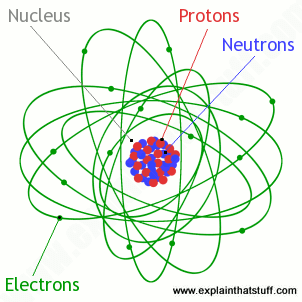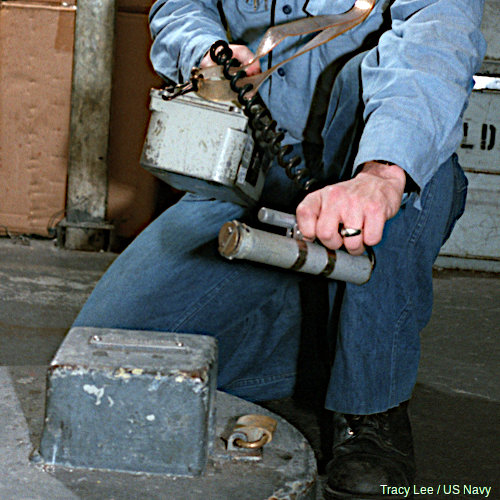
Geiger counters
by Chris Woodford. Last updated: September 26, 2023.
Click click click! Thanks to an ingenious German physicist named Hans Geiger, we've all heard the sound of radioactivity. It's just as well we do have Geiger counters because most radiation (radioactive particles and energy) is extremely harmful to living things, completely invisible, and very difficult to detect in other ways. What are Geiger counters? How do they work? Let's take a closer look!
Artwork: The basic concept of a Geiger counter—a tube, attached to a meter, that can detect and measure particles of radiation.
Sponsored links
Contents
What is radioactivity?
There are several different types of radiation, caused by different processes. Cosmic rays, for example, arrive on Earth from outer space, but there's plenty of naturally occurring radiation here on Earth as well. Radiation is also made by artificial processes that happen inside nuclear power plants and nuclear bombs.
What causes radiation? Atoms of a particular chemical element often exist in slightly different forms called isotopes. The metal tin, for example, has ten stable isotopes: atoms that have the same number of protons and electrons (50 of each) but different numbers of neutrons. Stable isotopes are ones that are happy enough to stay as they are indefinitely: they have nothing to gain by changing into a different form. Not all isotopes are stable, however. Carbon has lots of isotopes, the two best known being carbon-12 (ordinary, stable carbon atoms with six protons, six neutrons, and six electrons) and carbon-14 (with six protons, eight neutrons, and six electrons). Having more (or fewer) neutrons than the ideal can make an atom so unstable that it spontaneously changes into a different, more stable atom or isotope by giving off some of its unwanted, subatomic particles or energy. Thus, carbon-14 atoms spontaneously (albeit very slowly) turn into nitrogen atoms. Atoms that are unstable in this way are called radioactive isotopes and the particles they give off are radiation. The kinds of radiation we're talking about are alpha particles (two protons and two neutrons joined together, so they're like the nuclei of helium atoms), beta particles (electrons traveling at high speeds with high energy), and gamma rays (very high energy electromagnetic rays—a bit like supercharged light rays, only invisible to our eyes and much more dangerous).

Artwork: Isotopes are atoms of an element that contain the same number of protons and electrons but different numbers of neutrons. An unstable (radioactive) isotope will naturally try to make itself more stable by getting rid of some of these particles and changing into a different atom.
Ionizing radiation
Whether they come from Earth or space, radioactive particles and rays have energy. Earth is surrounded by a blanket of gas (the atmosphere) so, when radioactive particles race through it, they collide with molecules of gases such as oxygen and nitrogen, splitting them apart into electrons and positively charged ions. This is called ionization. Now radiation may be impossible to see but detecting ions and electrons is much easier. That's the job that a Geiger counter does for us: it detects ionizing radiation by detecting the charged particles that the radiation creates as it passes through gases in the world around us.

Photo: A sailor with the US Navy uses a Geiger counter to check for radiation onboard a nuclear-powered vessel. Note the detector tube at the front and the handheld meter and loudspeaker in the separate box at the back. Photo by Tracy Lee courtesy of US Navy and Wikimedia Commons.
What is a Geiger counter?
A Geiger counter is a metal cylinder filled with low-pressure gas sealed in by a plastic or ceramic window at one end. Running down the center of the tube there's a thin metal wire made of tungsten. The wire is connected to a high, positive voltage so there's a strong electric field between it and the outside tube.
When radiation enters the tube, it causes ionization, splitting gas molecules into ions and electrons. The electrons, being negatively charged, are instantly attracted by the high-voltage positive wire and as they zoom through the tube collide with more gas molecules and produce further ionization. The result is that lots of electrons suddenly arrive at the wire, producing a pulse of electricity that can be measured on a meter and (if the counter is connected to an amplifier and loudspeaker) heard as a "click." The ions and electrons are quickly absorbed among the billions of gas molecules in the tube so the counter effectively resets itself in a fraction of a second, ready to detect more radiation. Geiger counters can detect alpha, beta, and gamma radiation.

Photo: Checking canned food for possible radioactive contamination back in 1963. This is a classic Geiger counter with the detector tube wired to a separate meter and a headset the operator wears to listen to the clicks. Photo by Warren Dobson courtesy of Centers for Disease Control (CDC).

Photo: Modern Geiger counters often have the two parts (detecting tube and associated electronics) packed into a single unit, with a digital display for easy reading. This is a Mirion ADM-300 with two built-in Geiger counters for detecting beta and gamma radiation and (inset) its LCD display. Both photos by Rhonda Smith courtesy of US Air Force and DVIDS.




